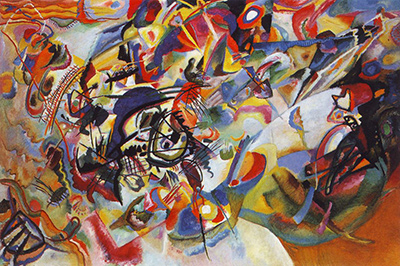The Russian artist, Wassily Kandinsky, created Composition VII in 1913. He was living in Munich at the time. This oil on canvas painting measures 200 x 300cm, and currently hangs in the Tretyakov State Gallery in Moscow.
Kandinsky was an art theorist, as well as an artist, and his writings and ideas had an enormous influence on 20th century art. When he painted Composition VII, he was part of a group called The Blue Rider, which included other artists such as Alexej von Jawlensky and Franz Marc. They argued that abstract art was as valid as representational art, and that art should express spiritual truths. The ideas of The Blue Rider were one of the driving forces of the Expressionist movement.
Kandinsky saw his art as linked to music, and used the terms ‘improvisations’ and ‘compositions’ to describe them. He reduced objects to symbols, eventually dispensing with them altogether, using colours and shapes to convey meaning. He believed paintings were a way of conveying spirituality and saw himself as a poet, as well as an artist. Composition VII may appear to be a random choice of shapes and colours, but it was meticulously planned out for several months prior to its final creation, which took Kandinsky four days. Prior to that, he made over 30 sketches, using oil paints and watercolours, carefully photographing each piece as he went along. See also Composition VIII.
Composition VII has a vortex-like design, with a central oval that is criss-crossed by black lines, around which a riot of colours and patterns swirl. The eye tries to pick out forms and make sense of them; perhaps the shape in the bottom left is a boat with oars, or we see a bird on a branch near the centre. A closer look, however, shows that nothing is representational in the painting and the whole piece is purely abstract. Out of the chaos of the intersecting forms and colours comes harmony. Composition VII has been called operatic, and Kandinsky believed that paintings could evoke sounds, just as much as music evoked images, and that both were a way of conveying emotion.
Another of his paintings, Composition VI, is very similar in size, design and colour palette. Both paintings were made in the same year. Composition VI was also called The Deluge, a word that Kandinsky repeated while he painted it in order to focus on the sound, rather than the meaning of the word. The extraordinary riot of colour and movement seen in these two paintings gave way, in Kandinsky’s later works, to a more formal, flatter, geometric style.
He became a part of the Bauhaus movement in the 1920s, and in paintings such as the 1923 Arch and Point used flat triangles and circles in primary colours, usually outlined with black edging. The shapes he used were now more recognizable, and geometry was used to control the chaos that he unleashed in earlier works like Composition VII. In 1924 he formed a group called The Blue Four, which included Paul Klee, with the aim of exhibiting their work overseas. In the 1930s, Kandinsky returned to a large-scale, more elaborate style of painting with Composition IX and Composition X.




